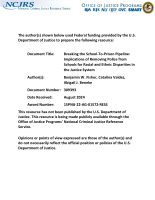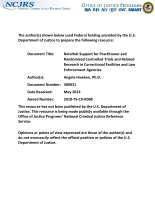Criminal justice systems
Development of new cocaine hair testing guidelines: investigation of decontamination protocols, damage/adulteration evaluation, and cosmetic treatment impact
A Comprehensive Evaluation and Error Rate Assessment of Field Colorimetric Testing for Seized Drugs
Early Intervention for Victims of Crime: Evaluation of Skills for Psychological Recovery
Procedural and Structural Justice Through Causal Understanding, Component Decoupling, and Relation Characterization
Disaggregated Estimates of the Prevalence of Trafficking in Humans (DEPTH)
Improving police-public relationships through intergroup contact: A mixed-methods evaluation of the Voices communication intervention
Building the Capacity of Community-Facing Agencies to Implement Evidence-Based Practices
Spatial analysis of social vulnerability and crime disparities through interpretable machine learning
MDI Myth: Rapid Toxicology Screening Tools Can Replace Traditional Toxicology Testing – No Need to Confirm
Breaking the School-To-Prison Pipeline: Implications of Removing Police from Schools for Racial and Ethnic Disparities in the Justice System
Five Things About Women and Reentry
NIJ FY24 Invited to Apply - Byrne Discretionary Community Project Grants/Byrne Discretionary Grants Program
Attitudes Toward Police and Judges of Latina Immigrants With a Justice-Involved Child: Do Documentation Status and Family Deportations Matter?
NIJ Journal No. 282 — Violent Crime
NIJ Journal No. 283 — Children and Youth
NIJ Journal No. 285 — Focus on Domestic Radicalization and Terrorism
Ethical Data Sharing in Forensic Research
BetaHub Support for Practitioner-Led Randomized Controlled Trials and Related Research in Correctional Facilities and Law Enforcement Agencies
Closing Cases Using Gunshot Residue
Closing Cases Using Gunshot Residue
Not every crime scene will have definitive evidence, such as DNA, to link an individual to a crime. In those cases, law enforcement relies on other evidence to build the burden of proof. NIJ graduate research fellow Dr. Shelby Khandasammy developed a tool to analyze organic gunshot residue and distinguish between different firearms calibers and manufacturers. She joins Marie Garcia, office director for the Office of Criminal Justice Systems at NIJ, to talk about her work and experience as a research fellow.





